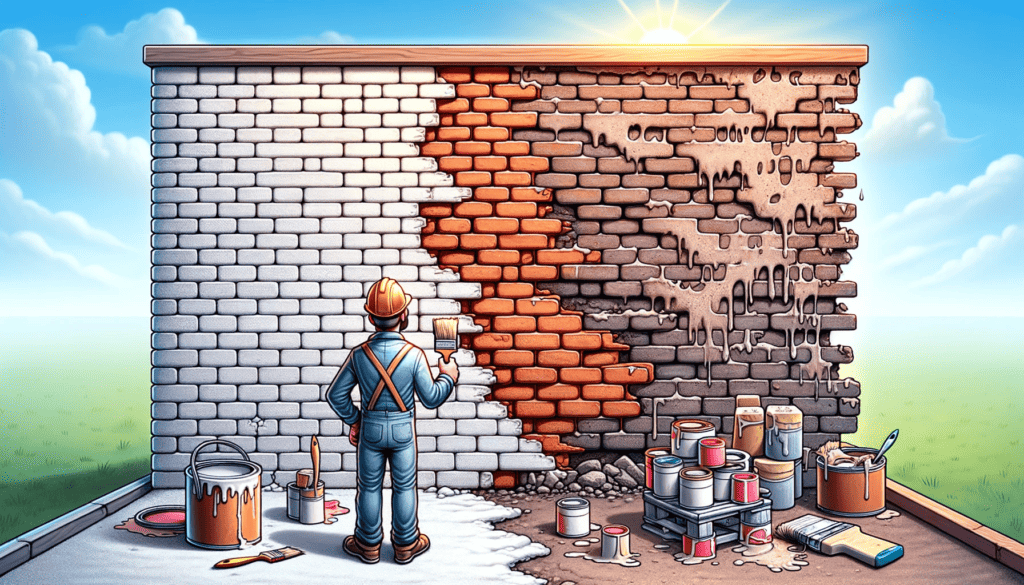
Painting brick may seem like an easy way to update the look of your home. However, painting brick is not recommended in most cases. Here’s an in-depth look at why you shouldn’t paint brick.
Paint Traps Moisture and Damages Brick Over Time
One of the main reasons not to paint brick is that it traps moisture inside the bricks, leading to long-term damage.Brick is designed to breathe and allow water vapor to evaporate over time. This is part of what makes brick so durable. When you paint brick, you seal in moisture and block the brick’s natural breathing ability.Over time, trapped moisture can cause:
- Erosion and deterioration of the brick surface
- Growth of mold, mildew and algae
- Damage from freeze/thaw cycles in cold climates
- Spalling (flaking of the brick surface)
- Efflorescence (white mineral deposits)
This moisture damage compromises both the appearance and structure of brick walls or homes.
Painting Conceals the Protective Qualities of Brick
Another reason not to paint brick is that you lose the natural protective abilities brick offers. The mineral composition of fired clay brick makes it naturally water-resistant and provides protection from weather, insects, and fire.When you cover brick with a latex paint, you lose these protective qualities. Any water that penetrates through the paint can become trapped and cause structural issues.
Painted Brick Requires High Maintenance
Over time, painted brick is almost guaranteed to show signs of wear including:
- Flaking and peeling paint
- Fading colors
- Growth of mold or mildew
This means painted brick needs frequent maintenance and repainting to maintain its appearance. And if the paint isn’t properly prepped, the new coat of paint may peel off even faster.In comparison, unpainted brick is extremely low maintenance. It develops a natural patina over time. Other than occasionally cleaning or re-pointing mortar, maintenance is minimal.
Paint Can Cause Permanent Damage to Brick
As mentioned above, trapping moisture in brick walls can cause permanent damage through spalling, efflorescence, erosion, and more. Repairing this type of damage is expensive and time-consuming.In worst case scenarios, the structural stability of a historic brick building may be threatened by painting. Brick restoration experts actually need to remove paint properly to assess underlying damage.So in addition to costing more for maintenance, painted brick can lead to costly repairs down the road.
Painting Conceals the Beauty of Brickwork
Brick is valued for its natural, earthy beauty and rich textures. Painting conceals the craftsmanship and appeal of historic or high-quality brickwork.For many homeowners, exposed brick walls provide character and charm. Interior designers also incorporate exposed bricks into rooms to add visual interest.Covering up brick with paint removes all these aesthetic benefits for the sake of a temporary color change. And keep in mind, fresh paint on brick rarely looks as nice as the real thing.
When Is It Okay to Paint Brick?
There are a few scenarios where painting brick may be acceptable:
- Covering up extremely damaged or mismatched brick
- Temporarily painting a building before full renovation
- Painting poor-quality brick in industrial settings
In general though, painting sound, high-quality brick is not recommended. And even then, proper preparation and paint selection is crucial to avoid moisture issues.
Tips for Preparing Brick Before Painting
If you decide to paint brick, proper prep work is absolutely vital:
- Inspect brick for cracks, damage, efflorescence, and moisture – address any issues first
- Clean brick thoroughly to remove any coatings, salts, or contaminants
- Allow brick to dry out completely before applying primer and paint
- Select a high-quality exterior masonry paint and primer made for brick
- Allow for proper curing time between paint coats
Even with perfect preparation, understand painted brick will require extensive maintenance to avoid peeling, cracking, and fading.
Maintaining Painted Brick Walls
To extend the life of painted brick, be prepared for vigilant maintenance:
- Inspect painted brick a few times per year for any worn spots or damage
- Repaint at first sign of fading or peeling paint
- Plan to re-paint every 3-5 years
- Address any moisture issues right away
- Be prepared to repaint again if paint doesn’t adhere properly
Proper maintenance can help painted brick last longer. But it will never be as durable or low maintenance as unpainted brick.
Removing Paint from Brick
If you decide you don’t like painted brick, removing the paint can be difficult. Paint strippers may work for latex paint. But multiple treatments are often needed.For oil-based paints, sandblasting may be required to get back to the bare brick. This should only be done by qualified professionals. Harsh chemicals or abrasives can damage mortar and the brick surface.Paint removal can also release lead paint dust if the building was painted prior to 1978. Proper containment and precautions are essential.In summary – think carefully before deciding to paint brick walls or structures. The drawbacks tend to outweigh the benefits in many cases. And reversing the decision can be difficult and costly.
Key Takeaways on Why You Shouldn’t Paint Brick
- Painting traps moisture and causes structural damage over time
- Paint conceals the natural protective qualities of brick
- Painted brick requires extensive, costly maintenance
- Painting can ruin historic brickwork and requires paint removal if reversed
In most cases, exposed brick should be left unpainted to showcase its timeless beauty and durability. Painting brick delivers only temporary, superficial benefits that fail to outweigh the long-term downsides.Carefully consider these factors before making a decision you may later regret. In most cases, the best choice is to leave your lovely brick untouched by paint!






Leave a Reply